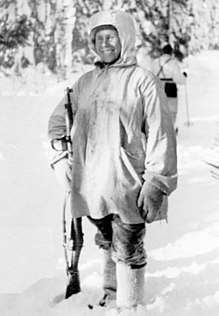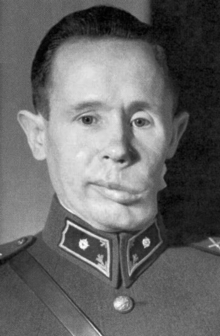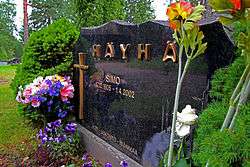Simo Häyhä
| Simo Häyhä | |
|---|---|
 Häyhä after being awarded the honorary rifle model 28. | |
| Nickname(s) | White Death |
| Born |
17 December 1905 Rautjärvi, Viipuri Province, Finland, Russian Empire |
| Died |
1 April 2002 (aged 96) Hamina, Finland |
| Allegiance |
|
| Service/ | Finnish Army |
| Years of service | 1925–1940 |
| Rank | Alikersantti (Corporal) during the Winter War, promoted to Vänrikki (Second Lieutenant) shortly afterward[1] |
| Battles/wars | |
| Awards |
Cross of Liberty, 3rd class and 4th class Medal of Liberty, 1st class and 2nd class Cross of Kollaa Battle[1] |
Simo "Simuna" Häyhä (Finnish pronunciation: [ˈsimo̞ ˈhæy̯ɦæ]; 17 December 1905 – 1 April 2002), nicknamed "White Death" (Russian: Белая смерть, Belaja smert; Finnish: valkoinen kuolema; Swedish: den vita döden) by the Red Army,[2] was a Finnish sniper. Using a Finnish-produced M/28-30 rifle (a variant of the Mosin–Nagant rifle) and a Suomi KP/-31, he reportedly killed 505 to 542 men during the 1939–40 Winter War, the highest recorded number of sniper kills in any major war.[3][4][5] Häyhä estimated in his diary he killed more than five hundred Red Army soldiers in the Winter War (by both sniper rifle and machine/submachine gun).[6] Antti Rantama (Häyhä's unit military chaplain) credited 259 confirmed sniper kills and an equal number of kills by machine/submachine gun were made by Simo Häyhä during the Winter War.[7]
Early life
Häyhä was born in the municipality of Rautjärvi in the Grand Duchy of Finland, in present-day southern Finland near the border with Russia, and started his military service in 1925. He was the second youngest of eight children in a Lutheran heritage family of farmers.[8] Before entering combat, Häyhä was a farmer and hunter. At the age of 20, he joined the Finnish voluntary militia White Guard (Suojeluskunta) and was also successful in shooting sports in competitions in the Viipuri Province. His home was reportedly full of trophies for marksmanship.[9]
Winter War service

During the 1939–40 Winter War between Finland and the Soviet Union, Häyhä served as a sniper for the Finnish Army against the Red Army in the 6th Company of JR 34 during the Battle of Kollaa in temperatures between −40 °C (−40 °F) and −20 °C (−4 °F), dressed completely in white camouflage. Because of Joseph Stalin's purges of military experts in the late 1930s, the Red Army was highly disorganized and Soviet troops were not issued with white camouflage suits for most of the war, making them easily visible to snipers in winter conditions.[10]
All of Häyhä's kills were accomplished in fewer than 100 days – an average of just over five per day – at a time of year with very few daylight hours.[11][12][13]
The number of killed Soviet soldiers was counted according to the sniper himself and with the confirmation of his comrades, only those who were killed for sure are considered. It was not taken into account when several snipers shot at the same target. The number of fatalities killed by the group leader was not counted, which was estimated to be more than 200, according to some sources.[14] However, Simo Häyhä's result is impossible to check, because his targets were always on the Russian side.[15] During the war, the "White death" was one of the leading themes of Finnish propaganda.[16] The Finnish newspapers frequently featured the invisible Finnish soldier, thus creating a hero of mythical proportions.[17][18]
A. Svensson, Häyhä's division commander, credited Häyhä with 219 confirmed sniper kills, and an equal number of kills by submachine gun, when he awarded Häyhä an honorary rifle on 17 February 1940. In his diary, military chaplain Antti Rantama reported 259 confirmed sniper kills and an equal number of kills by machine/submachine gun from the beginning of the war until 7 March 1940, one day after Simo Häyhä was seriously wounded.[2]
Some of Simo Häyhä's figures are from a Finnish Army document (counted from beginning of the war, 30 November 1939):
- 22 December 1939: 138 sniper kills[19] (138 in 22 days)
- 26 January 1940: 199 sniper kills[20] (61 in 35 days)
- 17 February 1940: 219 sniper kills[2] (20 in 22 days)
- 7 March 1940 (when Simo Häyhä was seriously wounded): total of 259 sniper kills[2] (40 in 18 days)
Häyhä used his issued Civil Guard rifle, an early series SAKO M/28-30 (Sn.35281/Civil Guard district number S60974). The rifle was a Finnish Civil Guard variant of the Mosin–Nagant rifle, known as "Pystykorva" (literally "The Spitz", due to the front sight's resemblance to the head of a spitz-type dog) chambered in the Finnish Mosin–Nagant cartridge 7.62×54R. He preferred iron sights over telescopic sights, as they enable a sniper to present a smaller target for the enemy (a sniper must raise his head a few centimeters higher when using a telescopic sight), can be relied on even in extreme cold (unlike telescopic sights, which tend to cloud up in cold weather), and are easier to conceal (sunlight can reflect off a telescopic sight's lenses and reveal the snipers' position). Häyhä also did not have prior training with scoped rifles, and therefore preferred not to switch to the Soviet scoped rifle (m/91-30 PE or PEM). Häyhä would frequently pack dense mounds of snow in front of his position to conceal himself, provide padding for his rifle and reduce the characteristic puff of snow stirred up by the muzzle blast. He was also known to keep snow in his mouth while sniping, to prevent his steamy breaths from giving away his position in the cold air.[21]
In their efforts to kill Häyhä, the Soviets used counter-snipers and artillery strikes, and on 6 March 1940, Häyhä was hit in his lower left jaw by an explosive bullet fired by a Red Army soldier.[22] He was picked up by fellow soldiers who said "half his face was missing", but he did not die, regaining consciousness on 13 March, the day peace was declared. Shortly after the war, Häyhä was promoted from alikersantti (Corporal) to vänrikki (Second lieutenant) by Finnish Field Marshal Carl Gustaf Emil Mannerheim.[23]
Häyhä's recollections, written in 14 August 1940 after being wounded, tell that Häyhä also had a lighter, humorous side to him: "After Christmas we caught a Ruskie, blindfolded him, spun him dizzy and took him to a party in the tent of The Terror of Morocco. The Ruskie was joyed by the carousing and was disgusted when he was sent back."[24]
Later life

It took several years for Häyhä to recuperate from his wound. The bullet had crushed his jaw and removed most of his left cheek. Nonetheless, he made a full recovery and became a successful moose hunter and dog breeder after World War II, and even hunted with the Finnish President Urho Kekkonen.[21]
When asked in 1998 how he had become such a good shooter, Häyhä answered, "Practice." When asked if he regretted killing so many people, he said, "I only did what I was told to do, as well as I could." Simo Häyhä spent his last years in Ruokolahti, a small municipality located in southeastern Finland, near the Russian border.
Death
Simo Häyhä died in a war veterans' nursing home in Hamina in 2002 at the age of 96,[23][25] and was buried in Ruokolahti.
Cultural depictions
Simo Häyhä was the inspiration for "White Death," a song from the album Coat of Arms of Swedish power metal band Sabaton.[26]
References
- 1 2 Lappalainen, Jukka-Pekka (6 December 2001). "Kollaa kesti, niin myös Simo Häyhä" [The Kollaa held out, so did Simo Häyhä] (fee required). Helsingin Sanomat (in Finnish). Helsinki. Retrieved 19 February 2011.
- 1 2 3 4 The White Sniper: Simo Hayha
- ↑ Rayment, Sean (30 April 2006). "The long view". The Daily Telegraph. London. Retrieved 30 March 2009.
- ↑ Saarelainen, Taipo (15 November 2016). "The White Death: History's Deadliest Sniper". Forces Network.
- ↑ Tapio A.M. Saarelainen: Sankarikorpraali Simo Häyhä (2006)
- ↑ Kauppinen, Kari (18 July 2017). "Sotasankari Simo Häyhän ennennäkemätön päiväkirja löytyi - "Tässä on minun syntilistani"". Iltalehti (in Finnish). Helsinki. Retrieved 18 July 2017.
- ↑ The White Sniper: Simo Hayha
- ↑ About Simo Häyhä
- ↑ Gilbert, Adrian (1996). Sniper: The Skills, the Weapons, and the Experiences. St. Martin's Press. p. 88. ISBN 0-312-95766-1.
- ↑ [pp. 145–146 The Winter War: The Russo–Finnish War of 1939–40 by William R. Trotter, Workman Publishing Company, New York (Aurum Press, London), 2002, First published 1991 in the United States under the title A Frozen Hell: The Russo–Finnish Winter War of 1939–40]
- ↑ Jowett, Philip S. (2006). Finland at War, 1939–45. Osprey Publishing. pp. 44–45. ISBN 978-1-84176-969-1.
- ↑ Pegler, Martin (2006). Out of Nowhere: A History of the Military Sniper. Osprey Publishing. p. 167. ISBN 978-1-84603-140-3.
- ↑ Farey, Pat; Spicer, Mark (5 May 2009). Sniping: An Illustrated History. Zenith Press. pp. 117–118. ISBN 978-0-7603-3717-2.
- ↑ https://www.is.fi/kotimaa/art-2000000854160.html
- ↑ Marjomaa, Risto: Häyhä, Simo (1905–2002). Teoksessa Suomen kansallisbiografia. 4, Hirviluoto–Karjalainen. Helsinki: Suomalaisen Kirjallisuuden Seura, 2004. ISBN 951-746-445-2 (viitattu 29.1.2008) - "Osuman tulosta ei tietenkään voitu varmistaa, sillä kohteet olivat venäläisten puolella"
- ↑ Journal of Information Warfare
- ↑ https://books.google.com.vn/books?id=rdIgAQAAIAAJ
- ↑ Suuret suomalaiset – 100 suurinta suomalaista: Simo Häyhä 2004
- ↑ JR34:n toimintakertomus 30.11.39-1.12.40. SPK 1327. Finnish National Archive Sörnäinen; Alikersantista vänrikiksi. Hurtti Ukko 1/1941
- ↑ Rantamaa, A. J. 1942. Parlamentin palkeilta Kollaanjoen kaltahille. WSOY, Porvoo. Pg. 84, 206
- 1 2 Stirling, Robert (20 December 2012). Special Forces Sniper Skills. Osprey Publishing. pp. 79–80. ISBN 978-1-78096-003-6.
- ↑ Saarelainen, Tapio (31 October 2016). The White Sniper: Simo Häyhä. Casemate. ISBN 9781612004297.
- 1 2 Feist, Paul (21 July 2012). "The Winter War and a Winter Warrior". The Redwood Stumper 2010: The Newsletter of the Redwood Gun Club, Arcata, CA. Arcata, CA: Redwood Gun Club. p. 36. ISBN 978-1-300-03973-0.
- ↑ Kivimäki, Petri (14 March 2018). "Tutkijan kädet alkoivat vapista – maailmankuulun sotalegendan Simo Häyhän muistelmat löytyivät sattumalta". YLE. Retrieved 14 March 2018.
- ↑
- ↑ "Sabaton Official Facebook". Sabaton. 17 December 2016. Archived from the original on 30 September 2017 – via Facebook.
Further reading
| Wikimedia Commons has media related to Simo Häyhä. |
- Meeting A Legend: Simo Häyhä. Mosin–Nagant.net 2002
- P. Sarjanen, Valkoinen kuolema. ISBN 952-5170-05-5.
- Tapio A. M. Saarelainen, Sankarikorpraali Simo Häyhä. ISBN 952-5026-52-3. http://www.apali.fi%5Bpermanent+dead+link%5D
- Tapio A. M. Saarelainen, The Sniper: Simo Häyhä. ISBN 978-952-5026-74-0. http://www.apali.fi%5Bpermanent+dead+link%5D
- William R. Trotter, Frozen Hell: The Russo-Finnish Winter War of 1939/40, Algonquin Books of Chapel Hill, 2000. ISBN 978-0-945575-22-1.
- Adrian Gilbert, Tom C. McKenney, Dan Mills, Roger Moorhouse, Charles Sasser, Tim Newark, The Sniper Anthology: Snipers of the Second World War, Pelican Publishing Company, 2012. ISBN 978-1-455616-82-4.